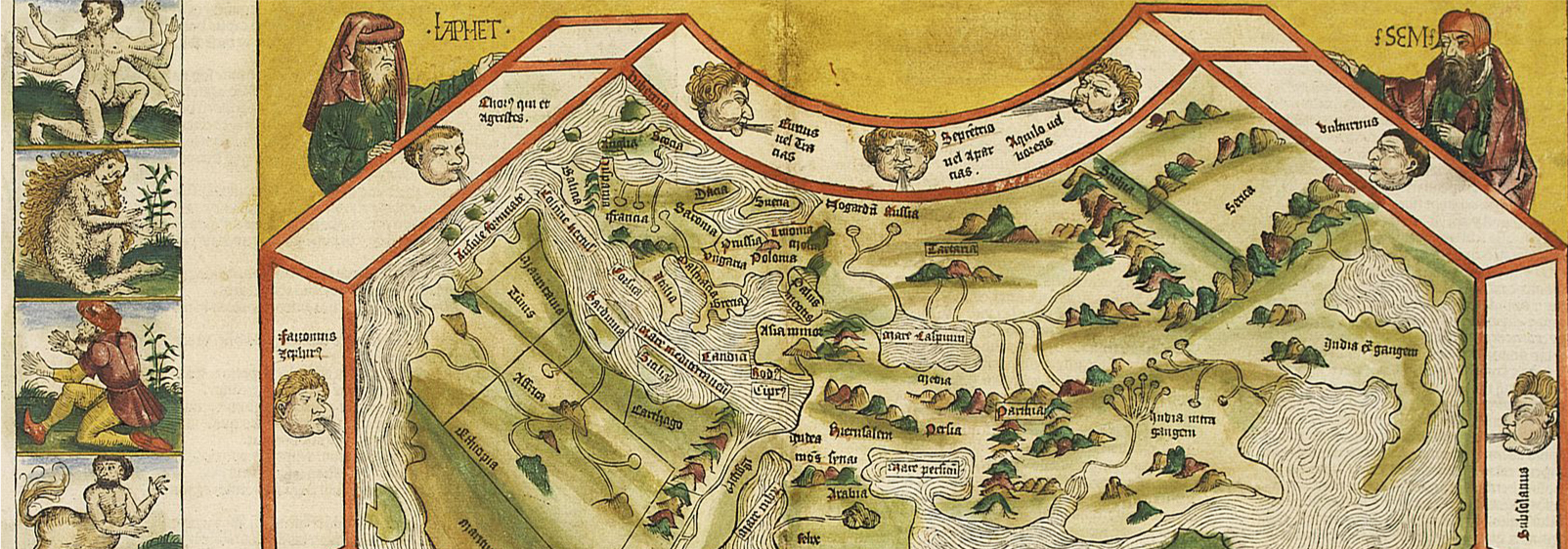Liber Chronicarum or the Nuremberg Chronicle
The Liber Chronicarum was commissioned by two wealthy Nuremberg merchants and brothers in law, Sebald Schreyer and Sebastian Kammermaister. They contracted Michael Wohlgemut (1434-1519) and his stepson Wilhelm Pleydenwurff (c.1460-1494) to make the woodcuts for the book and to draw up layouts showing the setting of the type and the placement of the woodcuts. The text was supplied by Hartman Schedel (1440-1514), a physician and humanist scholar. Schedel supplied little original material for the work but relied heavily on the work of others including Jacob Philip Foresti of Bergamo, whose Supplementum Chronicarumn was reproduced almost word for word. For some of the contemporary material he drew heavily upon Historia Bohemica, Rome 1475, by Aneas Sylvius Piccolomini. While Liber Chronicarum contains much historical material it also gives much room to accounts of curiosities, myths and fables. As notable as the material contained in Liber Chronicarum is what it leaves out. For example, the death of Lorenzo di Medici is not recorded nor is the adoption of Roman law in Germany. The famous printer, Anton Koberger (1445-1513), the largest printer and publisher in Germany at the time, was employed to print the book. At his height, Koberger ran 24 presses and employed 100 craftsmen. The Latin edition was published on 12 July 1493, and a German edition, translated by George Alt, the city scribe of Nuremberg, was published on 23 December 1493.
Perhaps the most important features of the Liber Chronicarum are its design and illustrations. The layouts for the illustration and typesetting of the book survive and show that the woodblock subjects were sketched at first and the text was then inscribed to fit within the remaining space. The result is a marriage between text and illustration never seen before. The artists produced fourteen basic page layouts, with a number of variations, for the book. They cut 645 different blocks and used some several times for the final 1809 illustrations, the same cut often being used to illustrate different towns or people. For example, the woodcut that is used to represent Damascus on fol. XVIII is used to represent Verona on fol. LVII and is also used to represent Mantua and Naples elsewhere in the work (see fig.3). However, in some of the depictions of the more important cities such as Jerusalem and Constantinople an effort has been made to put in recognisable landmarks. For example, we see the Temple of Solomon and other landmarks depicted in the woodcut of Biblical Jerusalem (see fig. 4). Some see evidence of the hand of Albrecht Dürer in some of the illustrations. Although this is possible, as he was apprenticed to Wohlgemut, this is doubted by many scholars.
The Nuremberg Chronicle receives much scholarly attention nowadays but the fact that some 800 examples of the Latin edition and 400 of the German edition are still in existence also testifies to the popularity of the Liber Chronicarum in its own time also. In fact, it is estimated that around 1500 copies of the Latin edition and 1000 of the German edition were printed. It was popular enough to be pirated. Three years after the first edition was complete Johann Schönsperger (d. 1520) of Augsburg printed a version in German and went on to produce an edition in Latin and another in German.
Further reading and books used in the compilation of this piece:
Adrian Wilson. The making of the Nuremberg chronicle. Amsterdam : Nico Israel , 1977.
Hartmann Schedel. Chronicle of the world : the complete
and annotated Nuremberg chronicle of 1493, introduction and appendix
by Stephan Füssel. Köln, London : Taschen, 2001.
Text by Hugh Cahill, Senior Information Assistant, Foyle Special Collections Library





